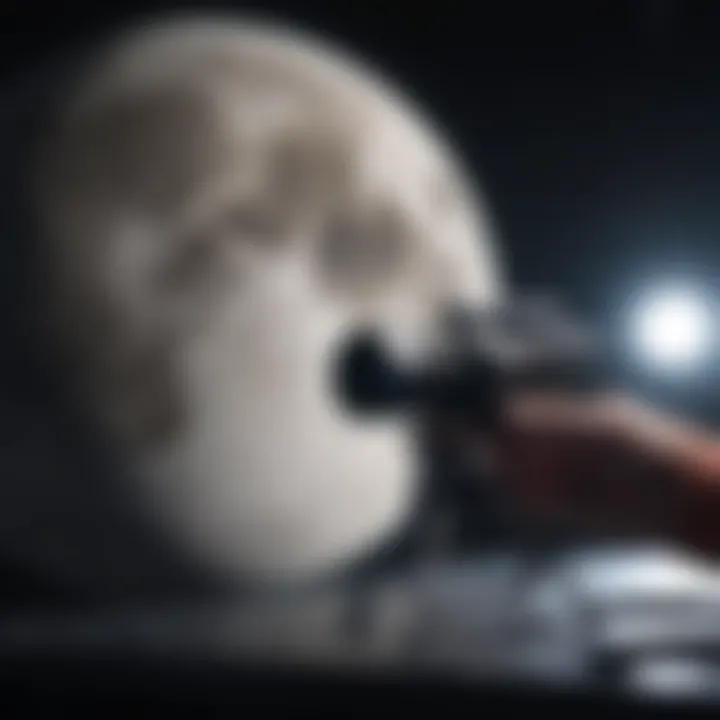Exploring the Moon with Live Telescope Technology


Intro
The Moon has long captivated human interest, serving as a constant object of fascination in our skies. As astronomical technology evolved, so did the methods for observing this celestial body. In recent years, live telescope technology has emerged as a revolutionary approach, allowing both amateur and professional astronomers to engage with lunar observations in real-time. This article provides a comprehensive guide to understanding how these advancements shape lunar exploration and research, and why this is important in the broader context of astronomy.
Article Overview
Purpose of the Article
This article seeks to explore the intersection of live telescope technology and lunar observation. It aims to elucidate how these advanced systems facilitate deeper understanding of the Moon and enhance public engagement with astronomical studies. By assessing the technological advancements and real-time observational capabilities provided by live telescope systems, the discussion will illuminate their impact on both research and education in the field.
Relevance to Multiple Disciplines
Understanding the Moon entails not just astronomy but also geology, history, and even philosophy. By integrating live telescope technology, educators can enhance curriculums in various disciplines. The ability to observe real-time data empowers students, researchers, and enthusiasts alike, fostering an interdisciplinary approach to planetary studies. This synergetic relationship between technology and disciplinary insights plays a crucial role in attracting new talents to the field.
Research Background
Historical Context
Since ancient civilizations, the Moon has been a subject of study. Initially, observations were made with the naked eye, leading to myths and legends. The invention of the telescope in the 17th century marked a significant leap forward. This technology expanded our understanding of the Moon's surface, revealing craters and maria. However, traditional telescopes often provided limited views and required expertise to interpret data.
Key Concepts and Definitions
To grasp the significance of live telescope technology, several key concepts must be understood:
- Live Telescope Technology: These systems allow for real-time data transmission, enabling immediate observation and analysis.
- Astronomical Studies: A field focused on celestial phenomena, where researchers analyze various bodies, including the Moon.
- Remote Observation: The ability to conduct observations without being physically present at the telescope site, which is enhanced by modern networks and digital platforms.
"The Moon serves not only as a scientific target but also as a canvas for human curiosity and exploration."
"The Moon serves not only as a scientific target but also as a canvas for human curiosity and exploration."
The integration of live telescope technology presents an exciting avenue for both scientists and enthusiasts, setting the stage for deeper insights and discoveries regarding our closest celestial neighbor.
Intro to Lunar Observation
Lunar observation serves as a fundamental pillar in the field of astronomy. The Moon, as the Earth's nearest celestial neighbor, holds invaluable insights into astrophysical processes that are crucial for comprehending our solar system. Understanding its geological features, patterns, and dynamics requires sophisticated tools and methods. This article explores the role of live telescope technology in enriching this field of study.
Historical Context of Moon Observation
The pursuit of lunar observation dates back to ancient civilizations. Babylonian astronomers meticulously recorded the lunar phases, while Greek philosophers proposed theories about its nature. Galileo Galilei is often credited with revolutionizing this study in the early 17th century. He pointed a primitive telescope towards the Moon, revealing previously unseen details like craters and highlands. This moment marked the awakening of a new era in celestial observation. As technological progress continued, astronomers made significant strides with instruments ranging from refractors to more advanced reflector telescopes.
"The Moon has always been a subject of intrigue and speculation, influencing cultures, art, and science across ages."
"The Moon has always been a subject of intrigue and speculation, influencing cultures, art, and science across ages."
The 20th century heralded the advent of space exploration and high-tech telescopes. The Apollo missions not only landed humans on the Moon but also dramatically expanded our understanding of its composition. The use of specialized telescopes focused on different wavelengths of light brought forth new revelations about lunar geology and atmosphere. Yet, despite these advancements, the quest for real-time observation has remained a challenge, leading us to the current applications of live telescope technology.
The Evolution of Telescope Technology
Telescope technology has undergone a remarkable transformation since its inception. Initially, telescopes were limited to simple optical instruments. The invention of the refracting telescope using glass lenses opened up new frontiers. These early designs had significant limitations, including chromatic aberration and size constraints. However, the introduction of reflecting telescopes by Isaac Newton proved to be a groundbreaking advancement. By utilizing mirrors, these telescopes delivered clearer images and eliminated distortion present in their predecessors.
As the understanding of optics progressed, so did the design of telescopes. The 20th century saw the emergence of larger and more powerful observatories equipped with advanced adaptive optics systems. These enhancements allowed astronomers to observe celestial bodies with unparalleled detail and clarity. The launch of space-based telescopes, such as the Hubble Space Telescope, circumvented atmospheric interference, facilitating deeper inspections of distant lunar features.
Today, live telescope technology combines wide access to remote observations with sophisticated real-time data analytics. It bridges the gap between professional astrophysics and amateur astronomy, making lunar observations more accessible and engaging. As we progress, the integration of software and automated systems continues to evolve. This allows for a more streamlined approach to lunar exploration that promises to benefit both researchers and the wider public.
Fundamentals of Telescope Design
Telescope design is foundational for effective lunar observation. Understanding the key elements involved in telescope construction helps appreciate how these instruments capture light from distant celestial objects. The optical design, materials, and mechanics play critical roles in achieving clear and precise images of the Moon. Given the advancements in live telescope technology, these fundamentals persist in shaping modern instruments.
Optical Elements and Their Functions


Optical elements serve crucial functions in telescopes, affecting the quality of observations. The primary components include the objective lens or mirror, eyepiece, and sometimes, a secondary mirror. The objective lens or mirror focuses light to create a clear image of the Moon's surface.
- Objective Lens/Mirror: This is the primary component that collects light. It gathers light from the lunar surface and brings it to a focal point. A larger aperture allows for more light capture, which is essential for detailed observations.
- Eyepiece: This element magnifies the image created by the objective. The type of eyepiece used can enhance the viewing experience, particularly for fine details on the lunar surface.
- Mounting Mechanism: This aspect stabilizes the telescope and allows for smooth adjustments. Accurate tracking of the Moon’s movement is critical for live observation.
The choice and arrangement of these optical elements greatly influence image resolution and clarity. Thus, understanding their functions can lead to better telescope selection and usage, improving the overall experience for observers.
Types of Telescopes: A Comparative Overview
There are several types of telescopes, each with unique features that suit different observational needs. A comparative overview aids in choosing the appropriate design for lunar observation.
- Refracting Telescopes: These use lenses to bend light. They can provide crisp images, making them popular for lunar observations. However, they can suffer from chromatic aberration, which may distort colors.
- Reflecting Telescopes: Utilizing mirrors instead of lenses, these telescopes can gather more light without the issues of chromatic aberration. They are commonly used for professional astronomical work.
- Catadioptric Telescopes: Combining lenses and mirrors, this type aims to eliminate the shortcomings of refractors and reflectors. They are versatile, providing good image quality and compact designs, suitable for both amateurs and professionals.
- Solar Telescopes: Designed specifically for solar observations, these instruments often have specialized optics to safely view the Sun. While not specifically for lunar observation, understanding their design can broaden insight into telescope technology.
Each type has specific advantages and limitations that cater to different stargazers' needs. The choice depends on factors such as budget, space, and intended use. Knowing the types helps in making informed decisions when investing in a telescope for lunar exploration.
Live Telescope Technology
Live telescope technology is vital in today's astronomical landscape, particularly when focusing on lunar observation. This technology enables real-time data collection and analysis, providing significant advantages over traditional observing methods. By connecting telescopes directly to the internet, astronomers can share their findings far and wide, presenting the Moon's surface and phenomena to an audience that previously had limited access.
The benefits of live telescope technology are manifold. It allows for collaborative projects between amateur enthusiasts and seasoned professionals. This integration fosters a community of learning and discovery, where knowledge is shared and expanded. Furthermore, this technology transforms astronomical data into educational tools, engaging students and non-specialists in meaningful ways.
Mechanics of Live Telescope Operation
The mechanics behind live telescope operation constitute a fascinating blend of engineering and astronomy. At the core, live telescopes utilize advanced optics to capture celestial images of the Moon and other astronomical bodies. These telescopes are typically equipped with high-resolution cameras that enhance the clarity of observing lunar details.
When an astronomer points a telescope at the Moon, a digital image is transmitted through a series of systems. The control mechanisms regulate the telescope's orientation and focus, ensuring precise tracking of the Moon’s movements across the night sky.
Once the data is captured, it undergoes real-time processing. This involves correcting for any atmospheric distortions or vibrations, which can significantly affect the quality of the observation. The outcome is a clear and detailed representation of the lunar surface, made available for viewers online immediately.
Software and Control Systems
The software and control systems in live telescope technology are pivotal to its efficacy. They serve multiple roles, from interface management to data processing. Typically, these software systems are designed to be user-friendly, allowing operators to adjust settings and access features without extensive technical expertise.
Control systems are responsible for managing communication between the telescope and the software interface. They ensure that commands are executed accurately and promptly. For example, a user might choose to zoom in on a specific lunar crater. The control system must interpret this command and adjust the telescope's mechanics accordingly.
In the realm of live astronomy, software also plays a significant role in data storage and analysis. Observational data can be archived systematically for future research. Moreover, advancements in machine learning and artificial intelligence are increasingly being integrated to predict lunar events and analyze data trends. This synergy of hardware and software enables astounding possibilities for both immediate observation and future lunar research.
Real-Time Observation Capabilities
Real-time observation capabilities represent a significant advancement in the field of lunar exploration through telescopes. These systems allow astronomers and enthusiasts alike to observe lunar features as they occur. This immediacy not only enhances engagement but also provides opportunities for deeper scientific insights. As live telescope technology continues to evolve, understanding its real-time capabilities becomes crucial for various applications in both amateur and professional astronomy.
Data Transmission in Live Observations
Data transmission in live observations is a key aspect that enables the transfer of real-time images from telescopes to users anywhere in the world. Advanced technologies such as high-speed internet links and satellite communications have transformed this process. The use of fiber optics, for instance, allows for rapid data transfer, facilitating higher resolution images without significant lag.
- Bandwidth: Ensuring sufficient bandwidth is critical. It guarantees that large amounts of data can flow seamlessly during observation sessions.
- Protocols: Various data transfer protocols are used to manage the flow of information. This includes methods such as TCP/IP, which help maintain the integrity and speed of the information sent.
- Compression Techniques: To optimize data transmission, compression algorithms reduce the file sizes of images without heavily compromising quality.
These technical components work together to create a seamless observing experience. Users can view celestial events, such as lunar eclipses or transient phenomena, in real time, elevating both the educational and enjoyment aspects of astronomy.
"The advancement of data transmission technology shapes the future of observational astronomy, bridging gaps between telescopes and audiences."
"The advancement of data transmission technology shapes the future of observational astronomy, bridging gaps between telescopes and audiences."
User Interfaces for Public Engagement
User interfaces play a pivotal role in the effectiveness of real-time lunar observations. They are the point of interaction for users, determining how easily information is accessed and understood.
Importance of User Interfaces
- Accessibility: A well-designed interface ensures people of all backgrounds and skill levels can participate in lunar observations. Simplified navigation allows users to focus more on the observation than on figuring out the system.
- Interactivity: Engaging elements like sliders for zooming in on features or buttons for changing filters can enhance the user experience. For instance, an interface might allow users to select different wavelengths to observe various features of the moon.
- Visual Feedback: Immediate visual feedback through diagrams or animated representations can help users understand the data in context. For example, a user observing a lunar cráter could receive real-time updates on its composition based on recent data calculations.
Through effective user interface design, live telescope technology not only makes lunar observation more enjoyable but also fosters community engagement. This can lead to collaborations among amateur astronomers, school groups, and research projects, enriching the overall astronomical landscape.


Applications in Lunar Research
The field of lunar research has seen significant advancements due to live telescope technology. This progress is crucial for enhancing our understanding of the Moon. Live telescope systems provide researchers with tools that facilitate detailed and immediate observations. Such capabilities have transformed traditional observational studies into dynamic, interactive exploration.
Researchers can gather images and data in real-time, enabling them to map features of the lunar surface accurately and understand various phenomena. This ability to observe lunar events as they happen contributes rich context to research initiatives.
Key elements of live telescope technology include:
- High-resolution imaging capabilities
- Real-time data transmission
- Accessibility for both professionals and amateurs
These factors make live telescope systems essential instruments for lunar study. They allow data to be shared easily, thus fostering collaboration.
Moreover, researchers can leverage software to analyze data immediately, making swift adjustments to focus and capture techniques as needed. This immediacy surpasses traditional methods, greatly accelerating the pace of discoveries in lunar geology and atmospheric studies.
Mapping the Lunar Surface
Mapping the lunar surface is a primary application of live telescope technology. Precise imaging is vital for understanding the Moon's geography and geology. Live telescopes continually capture high-resolution images of lunar formations.
This includes features such as craters, maria, and highlands, which are critical for geological classifications. The ability to observe these features helps in:
- Identifying potential landing sites for future missions
- Analyzing the Moon's geological history
- Understanding impact craters' formation processes
Furthermore, these observations can be used to create detailed maps that provide insights into the Moon's evolution over time.
Studying Lunar Phenomena in Real-Time
Studying lunar phenomena in real-time is another significant advantage of live telescope technology. Events such as lunar eclipses, transient lunar phenomena, and surface changes can be closely monitored as they occur.
This immediacy allows researchers to:
- Capture rare occurrences and provide real-time data for analysis
- Collect information on how certain events affect the lunar surface
- Validate or challenge existing hypotheses regarding lunar activity
Through live observation, astronomers gain insights that were previously difficult to obtain, enhancing our overall comprehension of the Moon. By engaging in such studies, they contribute to a larger body of knowledge in astronomy and planetary science.
"Live telescope technology has not merely altered how we view the Moon. It has redefined our approach to lunar research and broadens the scope of what we can achieve."
"Live telescope technology has not merely altered how we view the Moon. It has redefined our approach to lunar research and broadens the scope of what we can achieve."
Impact on Amateur Astronomy
The emergence of live telescope technology has transformed the landscape of amateur astronomy. This growing field allows enthusiasts to engage with celestial phenomena in ways that were previously unavailable. The ability to observe the Moon in real time provides unique opportunities for education, community building, and personal discovery.
Accessibility to Lunar Observation
With the advancements in live telescope systems, lunar observation is more accessible than ever before. High-quality telescopes, like those produced by Celestron and Meade, are now equipped to stream live footage over the internet. This means that anyone with an internet connection can explore lunar features without needing to invest in expensive equipment.
Amateur astronomers can now participate in live viewings from the comfort of their homes. Many organizations offer access to telescopes through online platforms, allowing users to select specific targets, such as craters and maria, with just a few clicks. This level of accessibility democratizes astronomy, breaking down barriers related to location, skill level, and financial investment.
Community Engagement and Collaboration
The impact of live telescope technology extends beyond individual observation; it fosters a sense of community among amateur astronomers. Online forums and social media platforms, including Reddit and Facebook, host vibrant discussions around lunar observations. Enthusiasts share their findings, techniques, and experiences, creating a collaborative environment that enhances learning.
Many observatories and astronomy clubs organize live sessions where participants can observe the Moon together, even from distant locations. This collective experience brings people together, encouraging interactions among enthusiasts who might not have met otherwise. Moreover, educational institutions can leverage this technology to conduct live classes, workshops, and demonstrations.
"Live astronomy broadcasts have changed how we as a community share our passion. Now, it's easier to connect and learn from each other."
"Live astronomy broadcasts have changed how we as a community share our passion. Now, it's easier to connect and learn from each other."
This sense of collaboration not only enriches the amateur astronomy community but also raises awareness about lunar science. As participants engage more deeply with the Moon and its features, they often inspire curiosity and passion in others. As a result, more students, educators, and curious individuals find their way into the field of astronomy, contributing to an ever-growing body of enthusiasts.
Challenges and Limitations


The advancements in live telescope technology have significantly shaped how we observe the Moon. However, it is essential to acknowledge the challenges and limitations that accompany these innovations. Understanding these factors is critical for optimizing the use of such technology in lunar observation. The efficacy of live telescope systems lies not only in their capabilities but also in their vulnerabilities.
Technical Constraints of Live Systems
Live telescope systems are complex and, at times, constrained by various technical limitations. The hardware used in these systems must be capable of processing huge amounts of data almost instantaneously. Latency can pose a significant issue, particularly when relaying real-time observations to users across different locations. If the data transmission is slow or inconsistent, the quality of the observation may suffer, leading to incomplete or less meaningful results.
Moreover, the resolution of images produced by these telescopes may not always meet the expectations set by professional astronomers or enthusiasts. Limitations in optical design and sensor technology can hinder the clarity of lunar images. For instance, while modern telescopes like the James Webb Space Telescope have advanced imaging systems, many live telescopes still rely on older technology that may not capture the fine details of lunar features.
"The most critical factor in live observation is ensuring that technical constraints are addressed effectively to enhance user experience and data quality."
"The most critical factor in live observation is ensuring that technical constraints are addressed effectively to enhance user experience and data quality."
Additionally, there is often a reliance on cloud-based technologies for the operation of these telescopes. This can lead to bottlenecks during peak user demand, compromising the fluidity of the observation experience. Ultimately, addressing these technical constraints is essential for maximizing the potential of live telescope systems.
Environmental Factors Affecting Observations
Environmental conditions are perhaps one of the most uncontrollable factors affecting live lunar observation. The atmosphere plays a pivotal role in the quality of astronomical imaging. Factors like light pollution, atmospheric turbulence, and weather conditions can significantly impact observations.
- Light Pollution: Urban areas often suffer from excessive artificial light which can obscure celestial objects. This makes it difficult for telescopes to capture high-quality data. Systems designed for live observation need to be situated in areas with minimal light interference to yield better results.
- Atmospheric Turbulence: Variability in the atmosphere can introduce distortion in the images captured. For instance, temperature variations can cause the light from the Moon to bend, leading to blurred observations. Live observing systems must account for these factors in their design.
- Weather Conditions: Cloud cover, humidity, and precipitation can render live observations ineffective. Scheduling and reliable operation become challenging during adverse weather conditions.
Future Directions in Lunar Observation Technology
The exploration of the Moon is entering a new phase marked by innovative technologies that enhance our observational capabilities. This section will discuss emerging technologies and the role of artificial intelligence, underscoring their significance in the context of lunar astronomy. The future of lunar observation will focus on improved precision, greater accessibility, and enhanced public engagement.
Emerging Technologies in Astronomy
Recent advancements in astronomy are reshaping how we study celestial bodies like the Moon. Key areas of development include:
- Optical Improvements: Emerging optical technologies, such as adaptive optics, increase the clarity of images captured from Earth. These systems adjust in real-time to distortions caused by the atmosphere, yielding sharper lunar views.
- Remote Sensing: Enhanced remote sensing systems allow for in-depth analysis of the Moon’s surface and composition. Using specific wavelengths, these systems can detect minerals and topological features that were previously unidentifiable.
- Integration with Communication Technologies: The amalgamation of telescopes with advanced communication technologies enables seamless streaming of celestial data. This allows researchers and enthusiasts instant access to live observations from various global telescopes.
This blend of technologies is revolutionizing lunar studies. The ability to gather precise data enriches our understanding of lunar geology and may lead to discoveries of new features or phenomena.
The Role of Artificial Intelligence
Artificial intelligence (AI) is becoming increasingly critical in the realm of lunar observation. Implementations of machine learning and data processing methodologies offer unique advantages.
- Data Analysis: AI can analyze vast amounts of observational data far more efficiently than human researchers. Algorithms can identify patterns and anomalies that may indicate novel lunar activities or features.
- Predictive Modeling: Machine learning models can predict lunar phenomena based on historical data. This capability enhances preparation for upcoming events and facilitates proactive research methodologies.
- User Experience: AI can transform user interfaces for public engagement. By leveraging natural language processing and machine learning models, astronomers can create systems that interactively guide users through observations and findings in simple, understandable terms.
"Technology is nothing if not translated into actionable insights. The combination of AI with telescope technology amplifies our ability to heed the whispers of the Moon."
"Technology is nothing if not translated into actionable insights. The combination of AI with telescope technology amplifies our ability to heed the whispers of the Moon."
In summary, the future of lunar observation relies heavily on technological innovation. With emerging technologies and AI, the field is poised for breakthroughs that enhance our understanding of the Moon and foster increased public interest in astronomy.
Epilogue
The conclusion of this article provides a final perspective on the importance of integrating live technology in lunar exploration. The advancements in live telescope systems have not only revolutionized how we observe the Moon but have also bridged the gap between professional researchers and amateur astronomy enthusiasts. This technology allows for real-time observation, enhancing scientific understanding and accessibility.
Summary of Key Findings
In summarizing the key findings, it becomes evident that live telescope technology serves multiple significant functions:
- Real-Time Data: Observers can collect and analyze lunar data instantaneously, fostering a dynamic study environment.
- Community Engagement: Platforms for live observation foster collaboration among amateur astronomers, creating a supportive community.
- Enhanced Research Opportunities: Researchers now have better tools for studying lunar phenomena, paving the way for discoveries that were previously difficult to obtain.
The combination of these advantages demonstrates that live telescope observation is essential for continuous progress in astronomy.
The Future of Lunar Exploration through Live Technology
Looking ahead, the future of lunar exploration through live technology is promising. Emerging technologies will likely bring several transformations:
- Integration of AI: Artificial intelligence can streamline data analysis, making it easier to identify significant lunar features and phenomena.
- Improved Accessibility: As technology becomes more advanced, even more users will gain access to these observations, breaking earlier barriers in astronomy.
- Global Collaboration: Live observational capabilities can foster international collaborative projects, leading to a more unified understanding of lunar science.
The ongoing dialogue between technological innovation and celestial exploration will undeniably shape future research. As we move forward, embracing these changes will be crucial for expanding our knowledge of the Moon.
"Technological advancement is imperative to unravel the complexities of lunar exploration and will determine our future understanding of celestial bodies."
"Technological advancement is imperative to unravel the complexities of lunar exploration and will determine our future understanding of celestial bodies."



